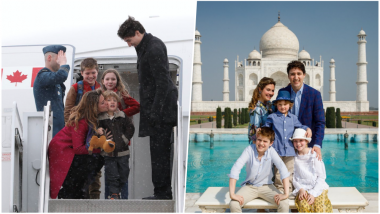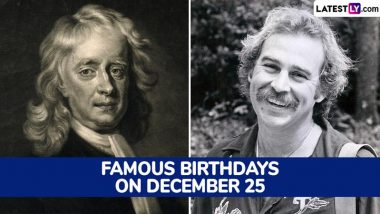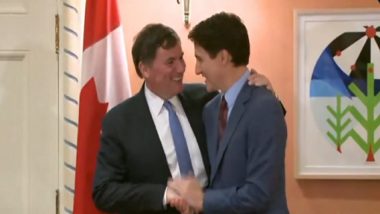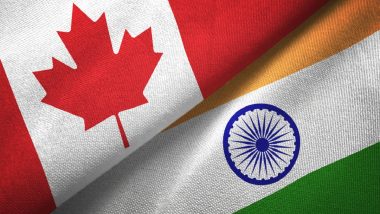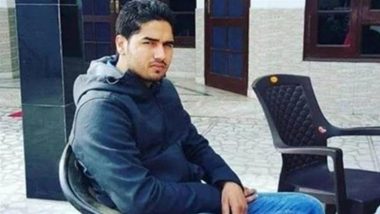New Delhi, February 19: Canadian Prime Minister Justin Trudeau is an extremely popular leader across the world; especially, in the time of Donald Trump’s presidency. Trudeau has come to symbolize globally what liberal democratic leaders should be like, and the fact only helps that he is young, dynamic and has been seen letting his hair down dancing bhangra and taking part in annual LGBTQ parades.
Trudeau and his family arrived in Delhi on February 17, 2018, Saturday. As he visits India for a week-long trip that is both business and pleasure, expectations are extremely high. Not only because his visit creates such good optics. Upon landing, Trudeau and family were received in by Gajendra Singh Shekhawat, Minister of State for Agriculture which is especially symbolic as India is a huge market for Canadian pulses and recent policy decisions by New Delhi has raised concerns in Ottawa.
I was about Xav's age when I first visited the Taj Mahal almost 35 years ago... and it's amazing to be back with him & the family on Day 1 of our trip to India. pic.twitter.com/EN6VnkYBU2
— Justin Trudeau (@JustinTrudeau) February 18, 2018
On the surface of it all, Canada and India should be best friends. Two commonwealth countries, both democracies with a shared set of values such as secularism and human rights, a history that goes back a hundred years and finally a 1.5 million strong Indian diaspora living in Canada. In fact, Trudeau is fond of stating that he has more Sikh ministers (four Sikh ministers) in his cabinet than New Delhi does.
.@WildlifeSOS accomplit un travail important consistant à rescaper des éléphants asiatiques tenus en captivité aux quatre coins de l’Inde et à leur donner un nouveau départ. Merci de votre accueil très chaleureux à votre sanctuaire aujourd’hui. pic.twitter.com/wS5qGox66M
— Justin Trudeau (@JustinTrudeau) February 18, 2018
But, the reality is much more complicated.
On the commerce front, bilateral trade totals up to $8 billion with an equal share of exports and imports on both sides. Canada exports pulses, precious metals, uranium, paper, fertilizers, and oil to India. India exports to Canada mineral fuels, organic chemicals, manufactured clothing, textile articles, pharma products, iron and steel products and some miscellaneous goods. This relatively short list pales in comparison to the diverse laundry list of goods that India trades with its top partners like China, U.S. and UAE. To underscore this reality is the fact that India and Canada do not even figure in each other’s top 15 trading partners list. This, despite successive Canadian governments marking India as a priority market since at least 2009.
To jog this bilateral trade relationship out of its perennial ennui, many an attempt has been made such as the continuing talks on a Canada-India Comprehensive Economic Partnership Agreement (CEPA). The last round of talks was held as recently as August 2017 in New Delhi. But, these were the tenth round of talks that were initiated almost a decade ago. Chances of this trade deal being concluded in 2018 seem remote as the current Modi government is moving into general election mode and the trade deal does not offer much in the form of vote bank returns.
However, when Trudeau was elected, he made it clear that he would like the country’s trade departments to focus on two countries – China and India. So why is it that Justin Trudeau is making his first state visit to India more than two years after he was elected? And his counterpart, Narendra Modi who has visited more than 50 countries in his tenure till date and has been to the U.S. five times but has never managed to cross the border north after Trudeau was elected.
The answer itself lies in the numerous trips abroad that both Justin Trudeau and Narendra Modi have taken. Modi paid a visit to Canada in April 2015, within a year of being elected. But since then Modi has focused on the big fish such as U.S., China and UK, countries that are home to multi-national companies and would set up factories as part of his Make in India programme. Similarly, Trudeau has focused south as the U.S. accounts for 86% of Canadian exports – worth 33% Canada’s of GDP. Life has not been easy for Trudeau with Donald Trump constantly threatening to upend North America’s biggest trade agreement. This volatility saw Trudeau focus his energy on the Trans-Pacific Partnership deal as well as court China.
But, the bilateral trade does not have to be the sum of bilateral relationships. Especially with a strong people-to-people ties already well-established between both countries. This is where domestic Canadian and Indian politics play the spoiler for Liberal PM Trudeau. As one Canadian commentator puts it, “When a Canadian politician visits India, he or she is also campaigning.” This is especially true for Trudeau as 19 of the 184 Liberal MPs in Ottawa are of Indian origin, and 17 of those from the Punjabi community. This is also why on Trudeau’s itinerary is a stop in Amritsar to visit the Golden Temple, the holiest shrine for Sikhs.
However, the Sikh community in Canada have a frosty relationship with the Indian government. Many Sikhs came to Canada after the riots of 1984 and still support the formation of an independent country for Sikhs called Khalistan. There has been a history of anti-Indian government protests in Toronto and elsewhere in Canada. But most recently, a private bill in Ontario’s local legislature was passed in April 2017 that termed the Sikh riots of ’84 as genocide. The Indian government lodged its protest but the bill passed with a majority vote. This growing space within the liberal camp for anti-India sentiment has meant that India is now cautioning Canada against sheltering ‘radical elements’ that could be a threat to India’s security. Canada for its part says it affords its citizens the freedom of expression and knows of no such threat to India.
To add to this, Punjab’s chief minister Captain Amarinder Singh accused Canada’s defence minister Harjit Sajjan of being a separatist supporter and refused to meet him on Sajjan’s trip to India in 2017. Khalistan is an especially touchy subject with Singh as his party’s former Prime Minister Indira Gandhi was gunned down by her own Sikh body-guards during the time of anti-Khalistan government action.
This time around as well there was much confusion if the two shall meet. The visit of a head of government to a state in India generally has the Chief Minister acting as the host however initially no such meeting had been scheduled. But, a day later a journalist travelling with Trudeau’s contingent reported that Trudeau and Sajjan would in fact meet with Singh in Punjab. Singh reportedly initially refused to meet the delegation but has said that he would like to meet Trudeau to raise his concerns. The issue of rising pro-Khalistan sentiment was reportedly discussed between Modi and Trudeau on the sidelines of Davos as well.
It seems the recent years of India-Canada bilateral has seen these frictions get highlighted as the leaders are focused elsewhere. Trudeau being the politician he understands this and hopes his trip to raise the bilateral discourse above the current nuisances. Which is probably why he is accompanied by six cabinet ministers; 14 MPs and one Senator are expected to join parts of his trip
As Trudeau travels across five Indian states, the state visit seems to be a comprehensive outreach attempt to India to move beyond the irritants of the relationship. It is a visit that wants to highlight positive growth like Canada Pension Plan Investment Board and Caisse de depot et placements du Quebec’s investment of hundreds of millions of dollars in India in recent years. It is also obviously to highlight untapped synergy areas such as renewable energy, fin-tech and infrastructure.
For the sake of both countries, here’s wishing Trudeau takes home from India more than just good photographs.
(The above story first appeared on LatestLY on Feb 19, 2018 11:55 AM IST. For more news and updates on politics, world, sports, entertainment and lifestyle, log on to our website latestly.com).













 Quickly
Quickly









